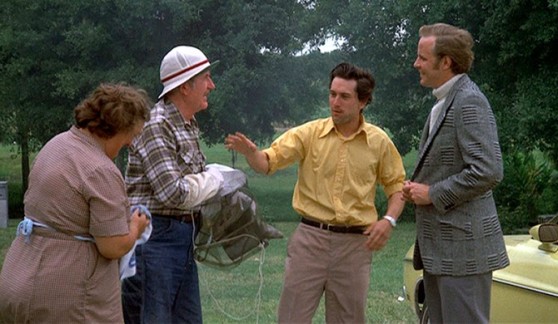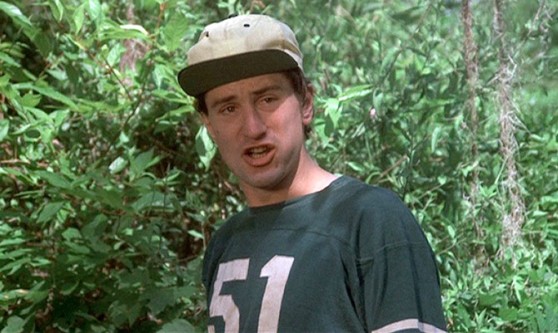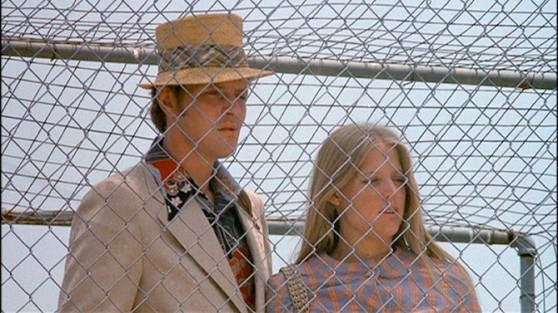Bang The Drum Slowly (…not THAT slowly)

Bruce Pearson (Robert De Niro), C-plus catcher for the New York Mammoths, finds out before the season begins that he has terminal Hodgkin’s lymphoma. The only other person he entrusts with the information is his roommate, Henry “Author” Wiggen (Michael Moriarty), who accompanied him to the Mayo Clinic and covers valiantly for Bruce when their manager, Dutch (Vincent Gardenia), spends more time trying to figure out what the eff the roomies got up to in Minnesota than he does fielding a decent lineup.
Eventually, Dutch uncovers the real reason for their road trip; eventually, everyone does, and a formerly fractious team that couldn’t pull it together to live up to its collective baseball potential is inspired to pull it together on behalf of its fading catcher, cohering around him for his last game.
That last bit is less nauseating than it sounds, especially since Bang The Drum Slowly began its life as a TV movie (audiences first saw it as an hourlong live presentation with Paul Newman as Wiggen and Albert Salmi as Bruce) based in turn on a novel — but the film is a dud, a mystifying selection as even a minor classic, because it has two fundamental problems. The first is that the basic plot premise of the movie is not credible; if Bruce’s Hodgkin’s is far enough advanced as to be completely untreatable, it’s too far advanced for him to play the bulk of a baseball season. And he’s not pinch-hitting here and there. He plays almost every day.

But the second, more serious problem is that the Hodgkin’s is Bruce’s, and Bruce as played by De Niro is an inscrutable and mannered dullard whom Wiggen doesn’t like much, prior to Bruce’s diagnosis. After his diagnosis, though, Wiggen is his champion and protector, teaching him the card games played in the bullpen, insisting that his contract contain a clause yoking him and Bruce together (one goes down to the minors, they both do), racing down hotel hallways in his curtain-patterned pajamas in the middle of the night to wake the team doctor when Bruce has the night sweats. Why? He’s intended, I think, as a charming bumpkin, but De Niro’s performance as a proto-Nuke LaLoosh is unconvincing across the board — the accent, which he allegedly went to Georgia to learn, is parodic; he chews tobacco like it’s a wad of Bubble Yum; he’s wearing a ballcap under the batting helmet. What, he’s in Little League? Most of that isn’t his fault, and nobody could have made the character convincing as an impetus for this level of Wiggen’s attention and sacrifice (and De Niro kind of took the role as a mitzvah in the second place; Al Pacino was already cast as Bruce, and when Coppola insisted he be released to shoot Godfather stuff, the producers basically “traded for” De Niro instead). But he’s mannered and off the beat, and if you don’t buy the character’s diagnosis and you don’t care in the second place, it’s a long sit.
Really, the story is about Wiggen, and Michael Moriarty is what makes BTDS at all worthwhile. Fortunately, he’s wonderful. He and this hat together are even more wonderful.

You forget for long stretches that Wiggen’s insistence on shepherding Bruce is sanctimonious and weird on paper, because Moriarty — as he often did on Law & Order — can elide bum beats, and make unbelievable dialogue seem like stubborn complexity instead of weak writing. It’s a valuable skill, and unlike his co-star, you don’t see Moriarty working so hard to seem natural. He just buys in and plays it. It’s a pity that he checked out of acting…or that the bellicosity of his pro-life beliefs indicated something rather beyond mere conviction. He was very good, and he could carry a bad haircut.
Does Moriarty make Bang The Drum Slowly worth investigating? Not quite, although it isn’t a dreadful movie; it has good things in it, like Danny Aiello’s gentle-brute film debut, and the naturalism of the baseball in both how it’s physically executed and how it operates in the story. (Here, De Niro’s legendary prep pays off. He looks just awkward enough for it to work.) Gardenia got an Oscar nom for his work as Dutch, and it’s the same Gardenia thing he always did, but the same Gardenia thing is likable. Give it ten minutes if it comes on cable, and if you don’t buy Bruce as touchstone (spoiler: you won’t), give it another fifteen to see Moriarty do his thing in a lavender suit, and then turn it off.
What is film fiber? It’s the movies I feel it’s necessary to have watched in order to participate in the cultural conversation. Canon, in other words, and whether it’s good or enjoyable isn’t the point. The point, as our exasperated sophomore-English teacher noted on the subject of The Scarlet Letter: “You can hate Pearl all you want, but if you can’t tell me what she means, you’re going to fail this class.”
For more bowls of Film Fiber, click the “Film Fiber” tag below.
Next up on Film Fiber, and I should note that these seldom remain accurate because I have an untreated queue-shuffling compulsion, but anyway, in theory it’s: Best Boy
Tags: Al Pacino Albert Salmi Bang The Drum Slowly Danny Aiello Film Fiber Francis Ford Coppola Michael Moriarty movies Paul Newman Robert De Niro Vincent Gardenia





Not knowing much about Moriarty, I looked him up on wikipedia, and interestingly–as it relates to this movie–his grandfather was a third baseman, umpire, and manager in MLB.
I watched this during my heady “Law & Order” obsessed days and it took me a few tries to imagine Moriarty *not* as Ben Stone. Once the gear clicked into place, I just loved him in this. It’s funny how it didn’t make his career, but also didn’t sink De Niro’s.
I’ve been informed by Moriarty scholars (there are some) that this film was hopefully to position him as the next Redford, and as you can see, that didn’t happen.
The best thing to come out of the movie for me was to have been convinced to go read the book series Moriarty’s “Author” character was based on, all four. Mark Harris’ “Southpaw” and “Bang the Drum Slowly” are terrific, both as historical looks at baseball when it was still a part-time sport for the players (the film moves it into the then-modern day) and for the development of the main character. Loved ’em.
Back in the day, Moriarty was value-added in any project for me. That is to say, I’d be more inclined to watch a thing if he was in the cast. One of the reasons I was disposed to like Mothership in its debut, if truth be told. And I’ve never seen this. A lot of my circle count this alongside Brian’s Song as pertains to ‘flicks it’s okay for guys to cry at’, which has always nudged it past my treacle-limit. Perhaps I’ll fiber up.
Were Wiggen and the hat perhaps preparing to understudy the role of Willy Wonka? Because that is quite the getup.
I had to look it up. Per Wikipedia, Moriarty’s Web site denounces “an eclectic array of targets,” including Bill Clinton, Islam, Sir Arthur Conan Doyle, George W. Bush, and Kenny G. Cuckoo, indeed.
He walked back the Islam foolishness, yeeeeears later, but: yeah, dude’s a Froot Loop.
He’s also a diagnosed manic depressive who has, at times, felt his medication was optional.
I dunno: Kenny G is a menace…
(says a person who owns some KG in her music library.)
So you’re saying looking for a connecting thread among the named targets is a mug’s game? (I’m finding Sir Arthur Conan Doyle the most henh-inducing of the bunch.) Eclectic, indeed.
Oh, wait: Maybe he was Googling himself and the Professor came up first? Never mind. [/Emily Litella]
[…] engaging pieces putting together movies with the national pastime, including this critique of Bang the Drum Slowly and this on Sports on Earth about some possible future projects. Not sure if the latter is the same […]
Reviewers should stick to what they know, and obviously the critic who authored the review above doesn’t know the difference between a story’s plot and its premise.
I remind the readers that the story was published in 1956, probably well before the writer of this review was even born. The movie itself is 40 years old. It is most likely a stretch for the writer to know the first thing about the diagnosis and treatment of Hodgkin’s lymphoma in the 1950s. In addition, it is pure conjecture on the part of the writer here to discount the relationship of Wiggen and Pearson before the opening scenes of the story. The alternative surmise is that the main characters had been battery mates and roomies LONG before the first page of the story.
As for the story’s plot, if it were a requirement that a story’s plot be true to life, then 90% of all stories would never be told. It is exactly the “larger than life” element in a story that an audience relates too.
Lastly, and most obviously, the reviewer here has never in her life played baseball on a team such as the Mammoths. Had she ever played on such a team, for even one day, all the pieces would fit together perfectly.
The movie is a classic.
obviously the critic who authored the review above doesn’t know the difference between a story’s plot and its premise
Oh, obviously.
This is my favorite baseball movie. It is funny and moving. The interactions between players, coaches, fans and hangers-on in the locker rooms, hotels and bars are amusing. Vincent Gardenia is hilarious as the Earl Weaver-like manager.
The movie pulls off the emotional parts without being maudlin. The actor’s playing action looks natural. De Niro’s accent sounds fine to me. The pennant race story is told in a refreshing, understated way unlike any other sports movie I’ve seen.
Watch it. It’s excellent. Pay for it if you have to. I have many times.